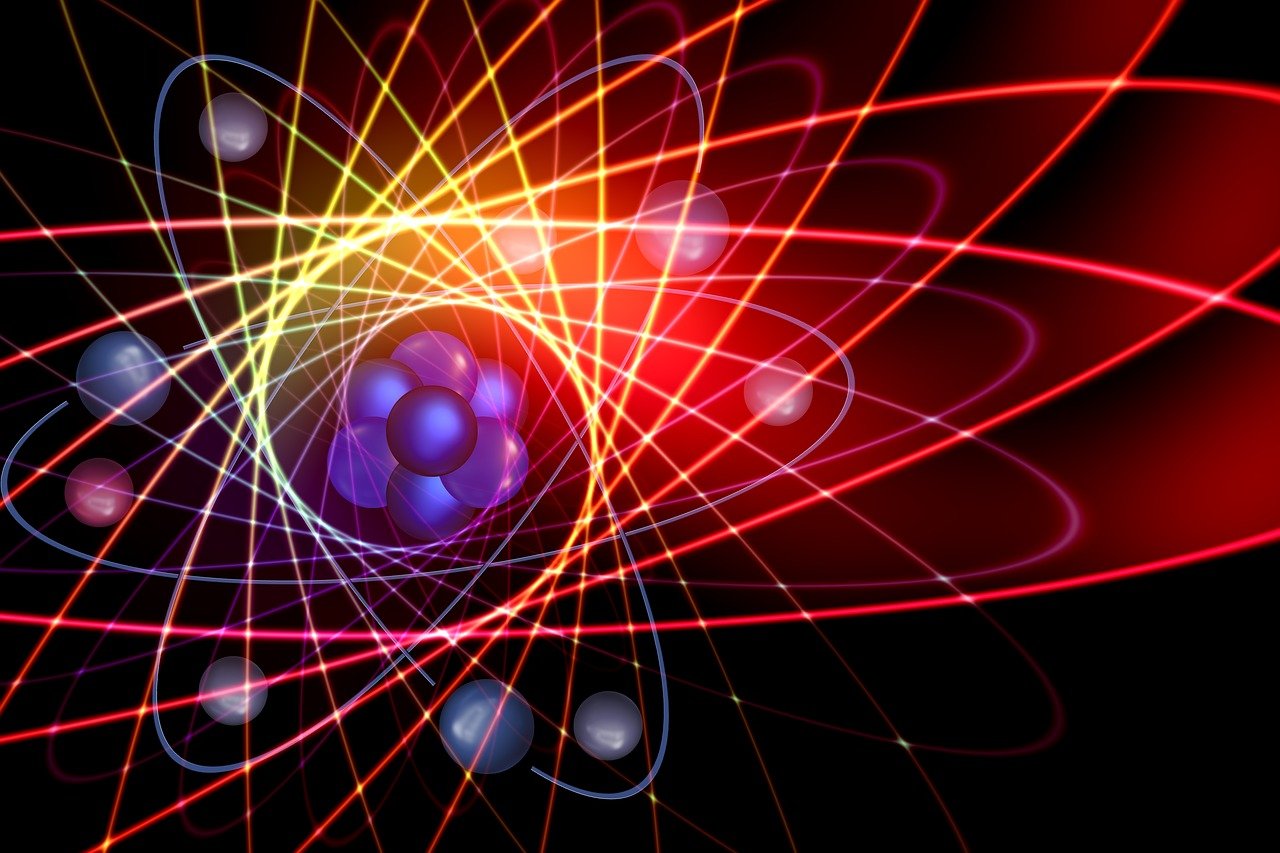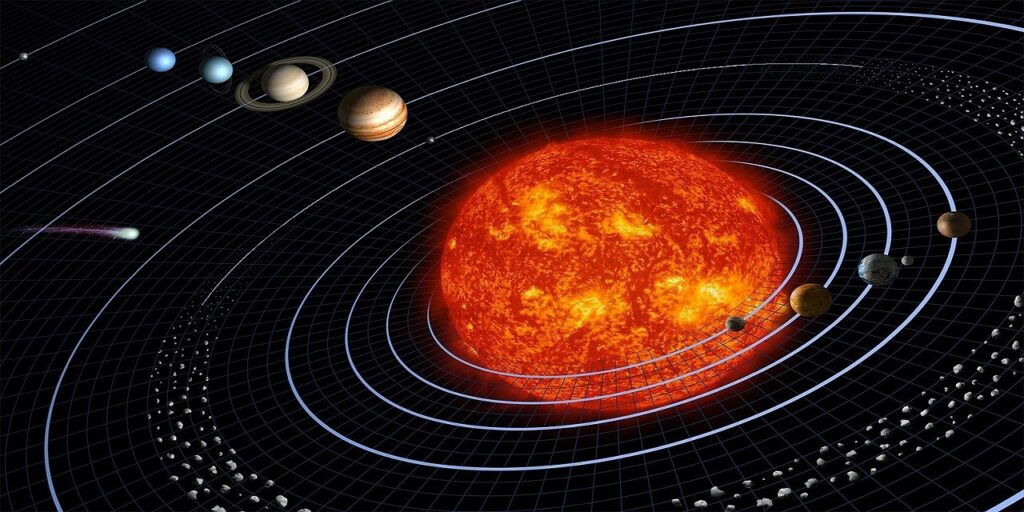Scientists estimate our universe is made up of 85% of dark matter, 4% of regular matter, and the rest of antimatter. Dark matter does not emit, reflect or absorb light and is glutone of our universe holding planets, stars, and galaxies. Antimatter is rarely found in the universe but scientists have succeeded in creating it in particle accelerator machines. Whatever we see, touch, and feel comprises matter, including ourselves, planets, and stars. Our Sun and Stars exist in a plasma state of matter.
Matter
Matter is any substance/material that has mass and occupies space. All living and non-living organisms are made up of matter including microorganisms to even big stars and galaxies. Matter exists in solid, liquid, and gaseous states at room temperature and pressure and in plasma states in ultra-high temperature and pressure conditions.
In the plasma state, the matter is in the form of fluid mainly gas. Under extreme temperatures and pressure, the electrons escape from the atomic orbit and move freely. Thus the plasma state is an electrically charged fluid that is affected by electrical and magnetic fields. Our Sun and other stars are in the state of plasma.
 Atom
Atom
On Earth, we see matter either in the form of elements, compounds, or mixtures. The atom is the smallest unit of regular matter. Atoms comprise protons, electrons, and neutrons; electrons are known as fundamental particles as they cannot be further broken down into sub-particles. Protons and neutrons are made up of tinier particles called quarks.
Every matter has some internal energy and the atoms vibrate continuously. We can touch and feel matter but in the case of light and sound where we can touch and feel respectively; but those are not considered matter. Light consists of tiny packets of energy called photons but it does not have mass so it is not a matter. Sound waves have some energy but do not have mass.
Physical and Chemical Properties of Matter:
Regular matter has physical and chemical properties. Physical properties include color, density, electrical and thermal conductivity, malleability, ductility, solubility, melting point, and boiling point.
Chemical properties include reactivity, flammability, toxicity, oxidation state, chemical stability, acidity or basicity, radioactivity, enthalpy of formation, and heat of combustion.
Matter Vs Antimatter
It has been proven that there exist antimatter particles corresponding to every matter particle. Positrons are antimatter to electron particles of regular matter. Studies say that matter and antimatter were formed at the time of the Big Bang event. Matter exists everywhere in the universe but antimatters are rarely found. Few theories about antimatter say that antimatter was produced equally to the regular matter at the time of the Big Bang and this has been a mystery about the rare existence of antimatter.
Antimatters are produced in the events like lightning strikes, radioactive decay, and cosmic rays. Scientists have also produced antimatter in the particle accelerator machine.
When regular matter and antimatter come in contact they annihilate(convert subatomic particles into radiant energy) and wipe out themselves releasing a tremendous amount of energy. Antimatter could be a future source of energy if we succeed in a complete understanding of its properties and control of the reaction.
Anti Matter
Antimatter is considered a mirror object of regular matter. Scientists say antimatter is real and it was created along with regular matter at the beginning of the formation of the universe which is the Big Bang but they wonder why antimatter is rare now.
Antimatter are similar to regular matter except they possess opposite charges and that is why they release tremendous amounts of energy upon contact. According to the mass-energy equivalence relationship, 1 gram of antimatter could produce 1.8×1014J of energy. Any real object that we see in this world would disappear instantly upon coming in contact with an equal amount of antimatter following the process of annihilation.
In regular matter, the electron has a negative charge whereas in antimatter positron has a positive charge. Positron is an antimatter partner of an electron having the same mass but opposite charge. Even other subatomic particles like protons and neutrons have their antimatter partners.
Can antimatter be created artificially?
Yes, antimatter particles have already been created artificially using the LHC, the world’s largest particle accelerator. Scientists have succeeded in creating antihydrogen particles. Anthihelium is another antimatter particle of Helium.
Several experiments at the Large Hadron Collider which is operated by CERN help scientists understand the properties of antimatter particles. They have also built a machine called Antiproton Decelerator(AD) that slows down antiprotons so that scientists can study and understand their properties.
The Large Hadron Collider is a powerful particle accelerator machine that helps scientists study the formation of the universe and other things like Matter, Antimatter, God particles, and Black holes.
The fact is that when matter and antimatter come in contact they annihilate and scientists wonder why only regular matter has dominated the cosmos. Many theories have been produced to understand the mystery behind the availability of antimatter since the formation of the universe or the Big Bang event.
Who discovered Antimatter?
British physicist Paul Dirac was the pioneer in predicting the existence of antimatter back in 1928. While working on a combined equation of quantum theory and special relativity to describe the behavior of an electron moving at a relativistic speed he found something unsatisfactory in his equation.
Dirac’s equation posed a vital problem. His equation could have two possible solutions, one with electronic with negative energy and one with electron with positive energy just like an algebraic solution of the equation: x2=9; x= +3 or x=-3.
From here the concept of antimatter arose, Dirac explained the existence of antimatter using the equation stating that for every particle there exists a similar oppositely charged particle. His equation for the discovery of antimatter made him win the Nobel Prize in 1933.
Dark Matter
Scientists believe throughout space there is a hidden substance that operates the cosmos; this is dark matter. Dark matter is completely invisible but scientists believe it exists and influence whatever we do. Even after decades of exploration into space, dark matter is still not fully understandable. Dark matter is the glutone of our universe that holds stars in the galaxies and can bend even light rays.
It is estimated that 85% of our universe is made up of dark matter but still, we don’t have access to at least 1 gram of dark matter. Scientists even cannot prove the existence of dark matter, all properties of dark matter are based on theories and their assumptions.
Regular matter is made up of electrons and protons, Scientists are still engaged in researching whether dark matter is a kind of particle.
How scientists detect dark matter?
Dark matter is detected due to its strong gravitational pull. The fact is that 85% of the composition of our universe is dark matter. It has now evident that dark matter has structured our universe by holding galaxies, destroying other cosmic structures, and even being responsible for the bending of light rays.
Dark matter exists since the formation of the universe and has always been mysterious about its properties since we cannot see it, touch it, or feel it. Dark matter is located in a region that is far from the Earth. Scientists should only rely on powerful sensors and instruments located on the Earth.
But one thing is known they possess a strong gravitational field and disrupt a galaxy structure. Dark matter does not emit light, does not reflect light, and does not absorb light.
Scientists hunt for dark matter using a telescope in the disrupted structure but find nothing as dark matter is completely invisible. So other techniques should be followed.
When was dark matter discovered?
The term dark matter was first coined in 1933 by Swiss-American astronomer Fritz Zwicky. While exploring space he finds unusual movements of the galaxies in the Coma Cluster.
Coma Cluster is a rich cluster of galaxies containing thousands of galaxy systems. A group of galaxies were revolving with unmatched speed around the Coma Cluster. Zwicky found that as per their masses, these groups of galaxies should revolve at a speed of 80 km/hr to stay connected with each other. But these galaxies were revolving at a speed of 1600 km/hr. At such a great speed these galaxies should shatter away from the Coma Cluster but a mysterious energy was holding them tightly.
Fritz Zwicky named this mysterious energy “Dokla Materia” which is dark matter in English. Scientists started calculating the masses of the outer stars of the galaxy required to stay connected with the galaxy system in order to predict the percentage of composition of dark matter and visible matter. It was found 85% of the mass was made up of dark matter.
Gravitational lensing:
Gravitational lensing is the distortion and magnification of light rays when it passes close to massive objects having ultra-strong gravitational fields.
Some galaxies appear distorted upon viewing through a telescope as if some celestial body has collided and stretched them but in reality, those galaxies are in their normal and stable state. The light rays have chosen paths to reach us not straight making them look stretched. These light rays have reached our eyes through a speck of dark matter that bends light due to its ultra-strong gravitational field.
A massive object can bend space and time according to the theory of relativity. And light has to follow the path of space-time curve giving rise to gravitational lensing. A massive clump of matter/object makes a gravitational lens and whenever light rays pass close to it bends.
Dark matter properties:
The dark matter has ultra-strong gravitational waves that can pull and distort the light rays. This property is based on experimental observations. In actuality, scientists have not tested not even a fraction of dark matter.
Scientist assumes that dark matter is a kind of massive particle but they do NOT like to interact with visible matter and so dark matter is also named as WIMPs.
WIMPs are assumed to be the building blocks of dark matter, they are heavy and electromagnetically neutral subatomic particles. According to a theory, when multiple WIMPs collide with each other they destroy themselves releasing energy in the form of high-energy gamma rays.
During the observatory, it is found that gamma-ray bursts can also be due to the collision of two black holes. There are lakhs of primordial black holes (PBHs) close to our solar system that exist in the cosmic web but recent experiments and calculations indicate that dark matter/WIMPs are not primordial black holes (PBHs).
The existence of dark matter is still on the hunt and it remains mysterious.
Useful Glossary –
- Electron – An electron is a negatively charged subatomic particle that continuously revolves around an atom’s nucleus.
- Annihilate – The process of destruction of matter by converting subatomic particles into radiant energy.
- Cosmos – Universe



